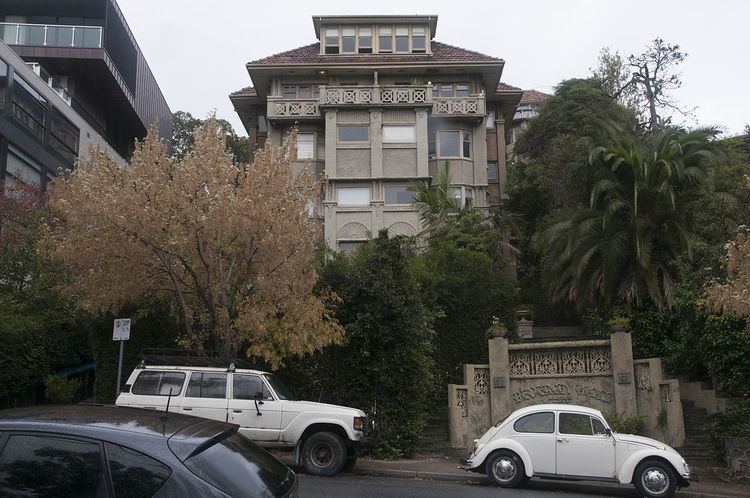 | ||
Beverley Hills Apartments are a complex of apartments designed and constructed by the architect and developer Howard Lawson between 1935 and 1936. Designed in two volumes, one behind the other, the complex is situated on 61-65 Darling Street South Yarra, and forms part of a larger precinct developed by Lawson and business partner Reginald Biffen between 1920 and 1942. Fusing together elements of the Spanish Mission style with Hollywoodesque glamour, the apartments were part of the early wave of apartment building in Melbourne and Sydney during the early twentieth century.
Contents
About the Architect
Howard Ratcliff Lawson (1886–1946) was an architect, property developer and builder most noted for his series of apartments constructed in South Yarra during the interwar period. Unable to gain registration as an architect due to his property development activities, Lawson famously advertised himself as ‘the architect who builds’. Lawson was best known for the many apartment blocks he designed and built in South Yarra, with the Beverley Hills complex being his largest and most notable.
Context
By the 1920s in Australia, the apartment was growing more common as an accepted means of housing, as areas like Potts Point and Darlinghurst in Sydney began to embrace higher-density living. However, despite an increasingly affluent clientele, there was still a widely held belief that flats were not fit for a home and high-density living was still often associated with the crowded workers tenements of North America and Europe. This led to attempts to ban flats outright by some local governments in NSW and Victoria and the different laws introduced by governments in the two states begin to create differing languages of design in the two cities, with Melbourne’s stricter laws creating a unique character of apartments in the city. Early Melbourne apartment blocks were rarely more than two storeys, set back from boundaries and more horizontal in form than their Sydney counterparts. These laws allowed the inner eastern suburbs of Melbourne to maintain their suburban, exclusive image.
It was against this backdrop that Lawson constructed his Beverley Hills Block, which, at five storeys high, caused a stir amongst nearby residents. Lawson’s future work on the site was subsequently restricted to 3 storeys, making the Beverley Hills complex unique in the area for its size and character.
Description
The apartments are separated into two volumes, one sitting behind the other, with each volume wrapping around an interior courtyard, allowing light and air to penetrate into the building. Heavily integrated into the landscape, plants are used to soften the overall form, allowing the otherwise dominant mass of the building to begin to be merged into the overall landscape.
Each apartment typically features 1-2 bedrooms and a small, corner kitchen, with the emphasis being on the living and master bedroom spaces. Most apartments maintain a strong visual connection to the outside through balconies, allowing sweeping views of the nearby Yarra River and surrounds.
Key Influences & Design Approach
Arguably the most flamboyant of Lawson’s work in South Yarra, Beverley Hills is designed in a Spanish Mission style. Reflecting the architectural legacy of Spanish Colonisation in the U.S.A., the style was particularly popular in California, New Mexico and Florida and brought together elements of Spanish Baroque with a romanticized image of the simplicity and monastic qualities of the early Spanish Missions. Brought to Australia in 1918 by Leslie Wilkinson, professor of Architecture at Sydney University, the style was popularized by many Hollywood stars during the interwar period, and became associated with glamour and luxury, influencing a number of up-market homes in and around Sydney. As evident in the name ‘Beverley Hills’, a clear reference to 'Beverly Hills' in Los Angeles, Lawson’s flats likewise express the opulence and grandeur of 1930s Hollywood, even featuring an under-water window into the swimming pool.
Architecturally, the building features the motif of a circle and a cross in the balustrading and detailing, seen in much of Lawson’s work. Like many Spanish Mission-style apartment blocks of the period, Beverley Hills features barley sugar-twist columns, bay windows and balustrade balconies and is constructed with brick bearing walls in accordance with council regulations of the period. The building is finished in grey stucco, with Spanish half-round terra cotta tiling on the roofs. The large mass of the building is punctuated by the horizontals of the balconies, which protrude from the surface of the building to create a layered façade. Predominantly geometric in its form, each building is capped by a medium-pitch hipped roof with a large dormer framing views of the river below. In keeping with the Spanish Mission style, the apartments are accessed through a portico.
Like the architecture, the choice of planting heavily references the Hollywood Spanish revival style, with palms and cactus featuring throughout the complex, as well as vines and creepers which soften the greyness of the stucco finish.
